Bajaj Auto Ltd unveiled 200 cc Pulsar DTS-i. The company hopes to sell 50,000 units of Pulsar per month from June, which will be available in 150 cc, 180 cc, 200 cc, and 220 cc engine capacities. In January, Bajaj Auto sold 43,000 units of Pulsar. Bajaj Auto will be unveiling its new platform of motorcycles in July-September this year. The company had last week announced exit from the 100 cc motorcycle segment.
The new Pulsar has many firsts to its credit. It comes equipped with an Oil cooler, which helps control engine oil temperatures at sustained high speeds and rpms, thus ensuring more stable engine oil viscosity. The 200cc DTS-I engine generates 18 Ps of raw pulsating power to provide riding excitement to performance hungry bikers. This makes the Pulsar 200 the most sporty and stylish powerhouse on two wheels to pace the Indian roads.
It’s also the first bike in India to feature both front and rear tubeless tires, which besides offering superior stability are safer than conventional tube types and in sync with the offerings abroad for similar applications. The rear tire is the broadest in its category to ensure better road grip and stability.
The new digital console is an advanced version of the latest Pulsar family. Apart from the Digital Odometer, Digital Speedo Meter, Digital Fuel Gauge and two Digital Trip Meters, the console on the 200 cc Pulsar DTS-I has indicators for Air filter condition, Engine temperature, Battery voltage and Oil level, all of which contribute to enhancing rider info for trouble-free riding.
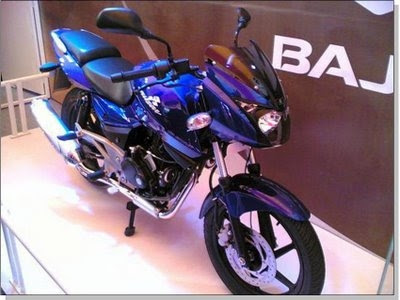
Latest Technology in Bajaj Pulsar:
DTSi - Digital Twin spark ignition: This technology helps the motorcycle a phenomenal performance augmentation and its being introduced for the first time in Bajaj Pulsar. Twin Sparkplugs for better and faster combustion in Bajaj Pulsar: As per convention there is only one spark plug at one end of the combustion chamber. This somewhat results in slow burning of air fuel mixture. 2 spark plugs at the either end of the combustion chamber helps in better and faster combustion Ignition handled by Digital C.D.I: A digital cdi powered by 8 bit microprocessor chip handles the spark delivery thus gives maximum efficiency to the bike. Constant velocity carburetor in Bajaj Pulsar: The CV carburetor provides high level of performance.
Bajaj Pulsar 200cc Test Ride
I took a test ride & I enjoyed the ride. Seating is not cushy but it took the bumps & pot-holes with ease. The foot pegs are not commuter style & I didn’t like it as i ride commuter bike. but to my surprise my posture was upright. It is even balanced but i was not able to do quick turn maybe because the bike is heavy or i didn’t have the confidence on my riding on a new bike. But vroom it & it literally flied over pot-holed road. It loves to be man-handled but note it on a straight road! The mid-range power just surges & makes you want more. But in slow speed she doesn’t responds well.
About oil cooler its utility as i read is to keep the performance at same level at ideal temp. Gear shift is good but not totally devoid of false neutrals albeit less than previous ones. About top speed they say it goes to 120km/hr but i feel it is exaggerated, plz comment on this. I believe it will go to max 115km/hr. About mileage they tell it will give 45 km/. The styling is a bit of this & that i expected at least a modified tank with new styling but what we get is an attached tank attachment. Yes if you see value 4 money it is good. With 124 kph showing on the orange-lit LCD speedometer of the new Bajaj Pulsar 220 DTS-Fi I’m on, I really should be doing other things. Like figuring out how to get the motorcycle to slow down for the uphill left turn that is coming up quickly.
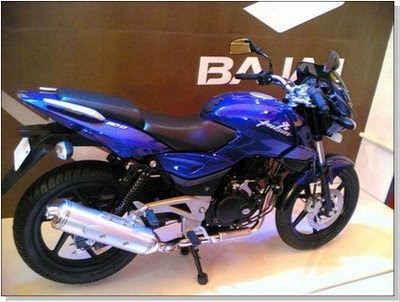
It really isn’t a concern, as the brakes are the best I’ve used. If my visor were dry and my raincoat was still in my kit bag, I’d probably be seeing closer to 135 kph on the speedo right now. On my umpteenth fast-but-not-pushing-it lap of Bajaj’s Chaka plant test-track, I’m impressed with the motorcycle and what it represents. we haven’t had this classy, this fast, this good a performance motorcycle at all. It takes corners with a delightful, eager poise, is accurate like a surgeon’s scalpel and can brake hard with easy confidence. The throttle is superlight and crisp and I can already see all sorts of careless riders using it to scare themselves silly. More importantly, I can see hordes of serious riders grinning in delight. Bajaj’s design brief for the DTS-Fi was to create a no-compromise machine for the performance motorcycle enthusiast. This, they have achieved.
Bajaj Pulsar 200cc Road Test
The DTS-Fi isn’t intimidating, too heavy or bulky for a 220cc bike. Its front fairing is larger than the older Pulsar, packs better weather protection and mounts a pair of attractive and angular mirrors. The fairing additionally supports a unique brace of vertically stacked headlights, which offer chaste white light. We haven’t yet taken the DTS-Fi out at night, but the twin 55W projector low beam and 70mm parabolic high beam assemblies scream potency — with Pulsar trademark twin pilot lights also offering white illumination.
The switchgear on the Pulsar DTS-Fi is backlit and contact-free. Positive to the touch, they go a step further, offering self-cancelling turn indicators. Instruments on the new Pulsar intelligently vary intensity to offer bright visibility during daytime and a more subdued, less obtrusive effect at night. Speed can be read off an electronic speedometer, which also employs a contact-free digital pick-up. The handsome, large rev counter is analogue and rider-friendly. Meanwhile, the array of warning lamps is astonishing — all those little bulbs have been replaced by LEDs and you get a fuel gauge with reserve warning flasher, twin trip meters, air filter choked, battery low, oil low, fuel low, engine redline flasher and engine overheating/malfunction lights, apart from the usual neutral, indicator and high beam indicators. And you would do well to not lose your new Pulsar’s pilfer-proof keys; these are virtually non-duplicable.
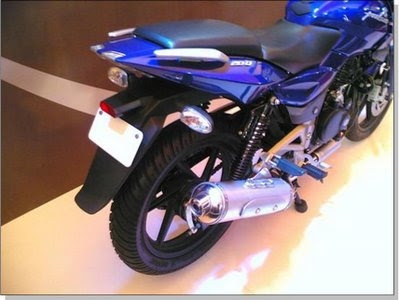
Thoughtfully, there’s a tank pad on this Pulsar to protect from belt/zip scratches as you sit on a lightly stepped seat surrounded by sporty two-piece grab bars. Flank panels and an exquisite tail fairing are all-new, as are a duo of flush LED break lamps. Adding meaty substance to this bike’s proportions is a stainless steel silencer that ends in a substantial alloy canister. This alloy theme is tastily extended to various other bits including the wheels, clip-on handlebars, triple-clamp, footrest mounts and fuel filler.
Bajaj has packed a whole lot of innovation and hard work into the Pulsar’s 220cc Digital Twin Spark-Fuel injected (DTS-Fi) engine (see ‘Technology - Fuel Injection, p118). Though it’s a single-cylinder mill that still runs twin valves, that’s about where the similarities with the other Pulsars end. Firstly, this self-started engine has shed its kick lever. Next, this air- and oil-cooled engine features an oil-radiator and a capillary of internal oil galleries that circulate and cool oil to disperse excess heat. As the name suggests, fuel injection and twin spark plugs work in tandem towards obtaining the best possible combustion in any situation.
The fuel injection system is computer-controlled — here, complex computation algorithms factor in a plethora of data including intake air mass, crank position, intake air temperature, throttle position and engine speed before deciding and delivering a precise air-fuel mixture at the intake tract. The sequence in which the twin plugs deliver their sparks also varies all the time, and is perfectly controlled to match every individual condition. And then the DTS-Fi motor enjoys some regular Bajaj features like roller bearings for the rocker arm pivots and camshaft interfaces, as well as an exhausted resonator that bumps up torque lower down in the power band.
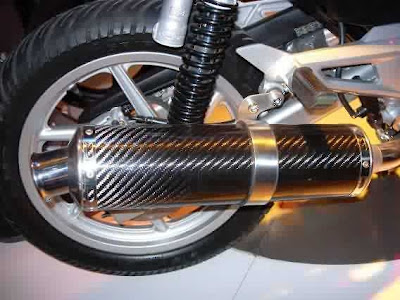
A counterbalance negates crank vibes, while the bike puts out a vigorous 20bhp power at 8500rpm. And 1.95kgm of torque is obtained at 6500rpm. The new Pulsar preserves its battery by tripping a circuit and pausing its engine-start sequence if the self-starter is engaged continuously for too long. It also automatically cuts the headlamp when the starter engages.
Fuel injection, like in any car today, translates into easy starts at any altitude or temperature. It also means cracking throttle response and an uninterrupted, flowing power delivery right through the rev band. In addition, you also can be assured of critical, behind-the-scenes benefits like good fuel efficiency and lower emissions. A five-speed, one-down-four-up gearbox does duty on the Pulsar DTS-Fi. Yet another significant feature is the exposed and ‘O’ ring sealed drive chain that comes with all links pre-lubricated and separately sealed for corrosion fortification caused by moisture and dirt. Expect this bike’s drive chain to offer minimal maintenance, increased reliability and good life in spite of running exposed to India’s harsh conditions.
We got to ride the DTS-Fi on Bajaj’s Chaka test track, and straight off we can tell you the bike sounds exciting and feels even better. Thumb the starter and its motor cracks in, immediately settling into a quiet and steady idle chatter. Clutch feel is spot on, with each gear clicking home with a positive shift action. Initiated Pulsar riders will immediately identify with this machine’s character-rich DTS-i whir as it fluently stretches stationary into fast-forward mode. The exhaust note, though soft and unobtrusive, also manages to offer a throaty tone.
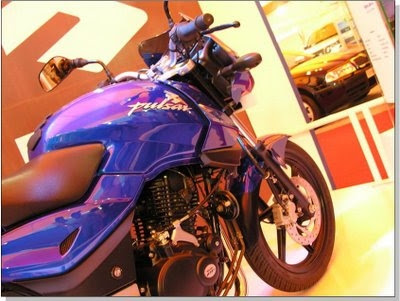
Performance is smooth, linear and torque laden, a light throttle delivering responsive power low in the band. It’s near-impossible to go easy on this bike as it piles on the revs with the furious feel of a far smaller and lighter machine. Smooth, vibe-free power coaxes you to push hard, slam home quick-shifts and ride silly speeds all the time. It took only one lap to feel at ease and start pushing the DTS-Fi for all its brawn. Chaka’s back straight is long and allows opening up and getting up close and personal with all those 20 horses. This new Pulsar feels perky, swinging smoothly from one end to the other of its rev-band, instruments flashing out an approaching redline and signaling time for each new gearshift. The bitumen was wet under a light drizzle, but we did comfortably nudge 124kph, with some power still in hand.
The DTS-Fi is composed at high speeds, with ample room to snuggle under its large front fairing and peer through its tinted fly screen. Bajaj claims a 135kph top speed and 50kpl as fuel economy — but we will get the complete picture only after a comprehensive road test. Riding position on the Pulsar DTS-Fi is unashamedly sporty, with damped clip-on bars, footrest pegs and stepped seat, all falling neatly into position. This is a bike that doesn’t feel its 150kg — it feels light and even nimble while cornering on its 17-inch wheels. While 37mm, pinched clamp telescopic forks bring up the front, the rear uses adjustable, dual gas-charged shock absorbers and an elliptical swing arm that mounts on slick needle roller bearings. The new Pulsar surely promises sparkling ride and handling, although our brief and wet ride forces us to reserve comment till later.
Meanwhile, for the first time in Indian motorcycling history, tyres have gone tubeless and have been specially developed by MRF for the DTS-Fi. Which brings us to the brakes — you get hydraulic discs, both front and rear. The front 265mm disc offers progressive and sure braking, and although we were initially worried about the 230mm rear disc possibly being too powerful, both ends actually are reassuring when braking hard through the gearbox at the end of the long, wet straight. Our few moments with Bajaj’s Pulsar DTS-Fi reveal that it surely has the goods to take forward the performance baton from the 180 DTS-i. This is clearly a no-compromise bike that’s going to have the competition curling their toes and breaking into a cold sweat. With undeniably good looks, a more-than-generous helping of features and clever engineering, the important questions now revolve around the DTS-Fi’s performance, price and the reliability of all the new technology. We feel Bajaj will slot this one in well under Rs 100,000 – good value for money in India, and if the bike reaches out further, a bargain abroad.
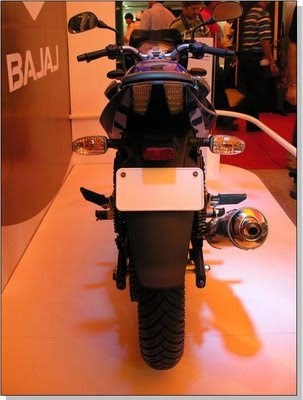
Engine and Transmission:
Pulsar 200cc features India’s first oil cooled engine which delivers a maximum power of 18Ps@8000rpm making it most powerful engine offered by Bajaj. It’s an air cooled single-cylinder with an alloy barrel and head as well as twin valves. Oil cooler placed just below the fuel tank helps in further cooling of engine lubricant and keep the large 198.8cc motor cool. Digital twin spark ignition (DTS-i) and torque expansion chamber — ExhausTEC ensures the pulsar to provide sufficient levels of torque at low engine rpm levels and is optimized to provide torque distribution in the mid and higher range rpm levels. Pulsar 200cc features a five speed gearbox with one down and four up pattern.
For the face lifted Karizma the engine remains the same. Karizma scores over the pulsar when comes to torque, the bigger engine provides a healthy 18.35Nm@6000rpm against the pulsar’s 17.17Nm. The progressive feel, multi-plate wet-type clutch and the smooth five-speed gearbox are again the same as in the previous version. Pulsar 200cc clocks a top speed of 121kph against the 125kph offered by Karizma 223cc. Pulsar 200cc is not quicker as Karizma 223cc and it cruises to 60kph from rest in 4.73 seconds. The pulsar 200cc offers an impressive mileage of 38.3kpl in city and 42.4kpl in highway against the Karizma offers only 30kpl in city and a decent figure of 45kpl in highway. Performance figures are taken from auto car India.
Bajaj Pulsar 200cc Design
When comes to cruiser bikes power and style is the deciding factor but with proven engines style occupies the centre stage. The two bikes derive their styling from their previous version and have added some interesting features. Pulsar 200cc derives its identity from 180 and 150. Bajaj’s new additions in Pulsar 200cc are:-
*Black paint theme carried over to the front fork legs, the rear shock absorbers, and the swing arm, in addition to the engine and six spoke alloy rims, for deadly looks.
* A lowered Headlamp/Fairing assembly along with a high tail-end, giving it an aggressive, ready to pounce stance.
* An all Stainless Steel silencer with an aluminum muffler can for genuine sporty looks and long life.
* Sleek, Twin row, Light-Emitting Diodes (LEDs) derived from the upgraded pulsar 180cc along the split grab rail perfectly compliments the new rear chiseled looks.
I have seen many Bikers love to alter their Pulsar 150cc, 180cc and other bikes with modern diffuser, more powerful horns, replacing rear tyres with bigger tyres, raising the rear suspension to give a racing look and exposing the drive train which demands higher price . For those relief comes in the form of pulsar 200cc Bajaj has offered some of these as standard features
* It’s the first bike in India to feature both front and rear tubeless tyres, which besides offering superior stability are safer than conventional tube types and in sync with the offerings abroad for similar applications. The rear tyre is the broadest in its category to ensure better road grip and stability. Another first is the use of split seats in pulsar 200cc for styling and comfort.
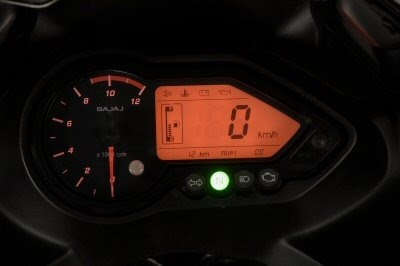
Handling and Engineering
Pulsar 200cc is lengthier than new Karizma but its wheelbase is shorter than new Karizma which means you have to be careful with the Pulsar 200cc while negotiating a turn. Both the bikes offer disc at the front and drum brake at the rear as a standard feature. With the MRF tubeless tyres at the front and the back Pulsar gives excellent traction control. Even though Karizma features a 276mm disc at the front a little larger than 260mm offered in pulsar, the massive 150kg Karizma comes to halt in 18.36m from 60kph as against 16.47m taken by pulsar 200cc from the same speed. Both the bikes offer a commanding position for riders. But with split seats and carefully placed foot rest the pillion in the pulsar 200cc gets better visibility. The split seats are not only meant for the sporty look, but also resides a modest lockable and cable released storage under it.
Special features
In addition to the features mentioned in design section both these bikes have special features which increases their practicality Pulsar 200cc also leaves its drive chain exposed with O’ ring sealed, which is pre-lubricated to help it stay reliable inspite of running open without protection is one such example. Similar to its sibling Pulsar 220cc-soon to be launched, the pulsar 200cc bike throws away the kick lever and makes you to crank the engine only with your thumb unlike the Karizma which offers both self and Kick mechanism for cranking.
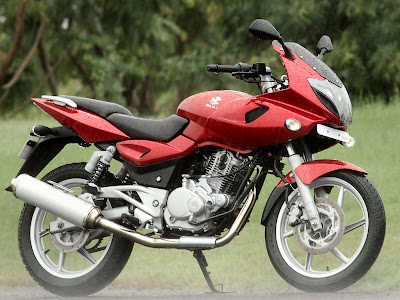
Both these bikes use best instruments and unheard features in any Indian bike. Both Pulsar 200cc and the new Karizma have Digital odo Meter, Digital Fuel Gauge and Digital Trip Meter. Pulsar 200cc features a digital console which uses only LEDs and intelligently varies its amber backlight intensity for viewing in either day or night. The new Karizma features a night vision in the digital console, which illuminates the console to bright neon yellow and makes the speedometer stand out in the dark, forming a stunning contrast. It also features powerful multi-reflector trapezoidal headlight with two pilot lamps for that added beam, an integrated clear-lens lamp tail light for better visibility at the rear. Real time clock is found only in the console of Karizma. Both these bikes use 15 liter reservoirs and bar end weights - which keeps off the vibration. Karizma has safety switch for clutch which actuates when the vehicle is started in gear.
Technical Specifications
| Engine | Type | 4-stroke, DTS-i, Oil cooled |
| Displacement | 198.8 cc | |
| Max Power | 18 Ps / 13.25 Kw | |
| Max Torque | 1.75 kgm / 17.17 Nm | |
| Suspension | Front | Telescopic forks 135 mm stroke |
| Rear | Triple rate spring, 5 way adjustable, gas charged NitroX shock absorbers | |
| Brakes | Front | 260 mm hydraulically operated disc brake |
| Rear | Mechanically expanding 130 mm drum type | |
| Tyres | Front | 90/90 x 17” Tubeless tyre, shod on aluminium alloy wheels |
| Rear | 120/80 x 17” Tubeless tyre, shod on aluminium alloy wheels | |
| Fuel Tank | Full | 15 Lts ( 2 liters of usable reserve) |
| Electricals | System | 12V AC + DC |
| Headlamp | 35/35W clear lens type with 2 pilot lamps | |
| Dimensions | Wheelbase | 1345 mm |
| Weight | 145 Kg |
Comments